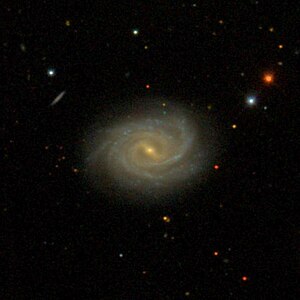NGC 4210
| Galaxy NGC 4210 |
|
|---|---|

|
|
| SDSS recording | |
| AladinLite | |
| Constellation | Dragon |
|
Position equinox : J2000.0 , epoch : J2000.0 |
|
| Right ascension | 12 h 15 m 15.8 s |
| declination | + 65 ° 59 ′ 07 ″ |
| Appearance | |
| Morphological type | SB (r) b / LINER |
| Brightness (visual) | 12.5 mag |
| Brightness (B-band) | 13.3 mag |
| Angular expansion | 2 ′ × 1.6 ′ |
| Position angle | 105 ° |
| Surface brightness | 13.6 mag / arcmin² |
| Physical data | |
| Affiliation | NGC 4256 group LGG 277 |
| Redshift | 0.009113 ± 0.000023 |
| Radial velocity | 2732 ± 7 km / s |
|
Stroke distance v rad / H 0 |
(127 ± 9) x 10 6 ly (39.0 ± 2.7) Mpc |
| history | |
| discovery | William Herschel |
| Discovery date | March 20, 1790 |
| Catalog names | |
| NGC 4210 • UGC 7264 • PGC 39184 • CGCG 315-028 • MCG + 11-15-039 • IRAS 12128 + 6615 • 2MASX J12151588 + 6559075 • GC 2801 • H III 850 • h 1143 • NVSS J121515 + 655856 • LDCE 889 NED004 | |
NGC 4210 is a bar-spiral galaxy with an active galaxy core of the Hubble type SBb in the constellation Dragon in the northern sky . It is estimated to be 127 million light years away from the Milky Way and has a diameter of around 75,000 ly.
In the same area of the sky are the galaxies NGC 4221 and NGC 4256 , among others .
The Type Ic supernova SN 2002ho was observed here.
Together with NGC 4108 , NGC 4221 , NGC 4332 , NGC 4256 , NGC 4513 and PGC 38461 , it forms the NGC 4256 group .
The object was discovered by Wilhelm Herschel on March 20, 1790 .
